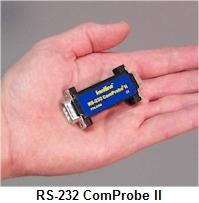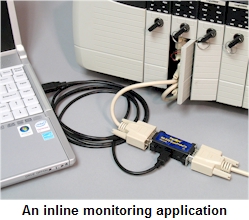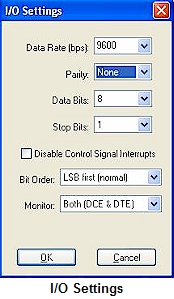Frontline’s “RS-232 ComProbe II” – A Portable, Rugged and Easy-to-Use Device for monitoring Asynchronous RS-232 communications
 The Serialtest®
analyzer supports the "RS-232 ComProbe II". Many laptops and PCs do not have PCMCIA interfaces and the PC industry
has migrated towards USB ports. To help our customers monitor
asynchronous serial communications via their PC's USB port, Frontline
has created the RS-232 ComProbe II. The RS-232 ComProbe II
is a flash drive-sized interface that plugs into a PC's USB port.
The Serialtest®
analyzer supports the "RS-232 ComProbe II". Many laptops and PCs do not have PCMCIA interfaces and the PC industry
has migrated towards USB ports. To help our customers monitor
asynchronous serial communications via their PC's USB port, Frontline
has created the RS-232 ComProbe II. The RS-232 ComProbe II
is a flash drive-sized interface that plugs into a PC's USB port.
The RS-232 ComProbe II monitors and captures Asynchronous RS-232
communications. It does not lose timing and control signal information.
With this interface, Frontline has made its Serialtest analyzer more
rugged, easier to use, portable and transportable. It allows you to
spend more time doing your real job.
Monitoring Flexibility
 The RS-232 ComProbe II provides customers a great deal of flexibility
in tapping into Async RS-232 bus configurations to address different
monitoring situations.
The RS-232 ComProbe II provides customers a great deal of flexibility
in tapping into Async RS-232 bus configurations to address different
monitoring situations.
The RS-232 ComProbe II can be used:
- Directly in-line or
- Connected via a combination of a provided Y-cable (enabling a
quick connection to permanent or semi-permanent tap into the
communication line) and/or the 6 foot RS-232 extension cable.
- Some monitoring situations may require a pair of 25-pin to 9-pin
adapters which are sold separately.
You can find more information on how to use these cables for various
monitoring situations on our Cable Setup
page. An example of an in-line asynchronous RS-232 monitoring
application is shown here.
I/O Settings
The RS-232 ComProbe II allows the user plenty of options for
monitoring various serial communication setups. The I/O Settings dialog
allows the user to configure the setup.
 The RS-232 ComProbe II supports data rates up to 921.6Kbps. The user
can pick one of the standard rates in the drop down box in the I/O
Settings dialog. For non-standard rates, the user can simply type in the
value in the box.
The RS-232 ComProbe II supports data rates up to 921.6Kbps. The user
can pick one of the standard rates in the drop down box in the I/O
Settings dialog. For non-standard rates, the user can simply type in the
value in the box.
The RS-232 ComProbe II can monitor serial communications with 5, 6, 7
or 8 data bits and with 1, 1.5 or 2 stop bits. The device also supports
all the standard parity types (None, Odd, Even, Mark, Space, and
Ignore).
The user can also choose the bit order on their serial communication
circuit. The choices are either LSB (least significant bit) first or MSB
(most significant bit) first. LSB first is normal, while MSB first is
considered "reversed" from normal. This option reverses the order of the
bits within each byte.
The user can also choose to monitor either DTE only, DCE only or both
DTE and DCE ends of the communication.
You can order your copy of
Serialtest online.